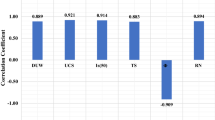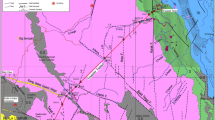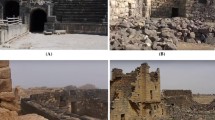Abstract
The measurement of thermal conductivity of granitic rocks is a time-consuming process and requires highly sophisticated instruments for experimental analysis. The difficulties in proposing reliable and precise empirical correlations and theoretical models forced the researchers to use alternative and more accurate models based on artificial intelligence (AI) techniques. The present study has been carried out to predict two parameters, thermal conductivity, and damage threshold for Jalore granite using AI techniques. In this study, artificial neural networks (ANNs), linear regression, support vector regressors (SVRs),, and decision tree regressors (DTRs) have been applied to obtain reliable and more accurate models. The extensive analysis revealed that the optimum performance is obtained by the ANN model with 8 nodes in the input layer with 2 hidden layers. Hidden layers having 15 and 7 nodes in the first and second layers, respectively. Softmax function has been applied as activation for each layer of the developed model. The mean absolute error (MAE) and mean squared error (MSE) values for the model while predicting the thermal coefficient were 0.0033671 and 184E−05. These values were 0.0016141 and 3.89E−06 for the damage threshold. DTRs with the number of estimators, n = 100, 1000, and 10,000 perform relatively well for predicting the values for both parameters. Linear regression and SVRs models (linear and robust kernel) show some deviations from the observed values at points where the trend shows a sudden change or kink. In the case of DTRs, the model with the number of estimators, n = 1000, and 100 performs most efficiently for predicting thermal conductivity (MSE = 6.81E−05) and the damage threshold (MSE = 2.84E−05), respectively.










Similar content being viewed by others
References
Abdulagatov IM, Emirov SN, Abdulagatova ZZ, Askerov SY (2006) Effect of pressure and temperature on the thermal conductivity of rocks. J Chem Eng 51(1):22–33
Hajihassani M, Marto A, Khezri N, Kalatehjari R (2015) Indirect measure of thermal conductivity of rocks through adaptive neuro-fuzzy inference system and multivariate regression analysis. Measurement 67:71–77
Ramazanova AE, Abdulagatov IM, Ranjith PG (2018) Temperature effect on the thermal conductivity of black coal. J Chem Eng Data 63(5):1534–1545
Sun Q, Zhang W, Zhu Y, Huang Z (2019) Effect of high temperatures on the thermal properties of granite. Rock Mech Rock Eng 52(8):2691–2699
Singh TN, Sinha S, Singh VK (2007) Prediction of thermal conductivity of rock through physico-mechanical properties. Build Environ 42(1):146–155
Vaferi B, Gitifar V, Darvishi P, Mowla D (2014) Modeling and analysis of effective thermal conductivity of sandstone at high pressure and temperature using optimal artificial neural networks. J Petrol Sci Eng 119:69–78
Sirdesai NN, Singh A, Sharma LK, Singh R, Singh TN (2018) Determination of thermal damage in rock specimen using intelligent techniques. Eng Geol 239:179–194
Chen YL, Ni J, Shao W, Azzam R (2012) Experimental study on the influence of temperature on the mechanical properties of granite under uni-axial compression and fatigue loading. Int J Rock Mech Min Sci 56:62–66
Zhang L, Mao X, Liu R, Guo X, Ma D (2014) The mechanical properties of mudstone at high temperatures: an experimental study. Rock Mech Rock Eng 47(4):1479–1484
Jha MK, Verma AK, Maheshwar S, Chauhan A (2016) Study of temperature effect on thermal conductivity of Jhiri shale from Upper Vindhyan. India B Eng Geol Environ 75(4):1657–1668
Zhang Y, Sun Q, He H, Cao L, Zhang W, Wang B (2017) Pore characteristics and mechanical properties of sandstone under the influence of temperature. App Therm Eng 113:537–543
Gautam PK, Jha MK, Verma AK, Singh TN (2019) Evolution of absorption energy per unit thickness of damaged sandstone. J Therm Anal Calorim 136(6):2305–2318
Liu S, Xu J (2014) Mechanical properties of Qinling biotite granite after high temperature treatment. Int J Rock Mech Min Sci 71:188–193
Lü C, Sun Q, Zhang W, Geng J, Qi Y, Lu L (2017) The effect of high temperature on tensile strength of sandstone. App Therm Eng 111:573–579
Verma AK, Jha MK, Maheshwar S, Singh TN, Bajpai RK (2016) Temperature-dependent thermophysical properties of Ganurgarh shales from Bhander group. India Env Earth Sci 75(4):300
Singh R, Kainthola A, Singh TN (2012) Estimation of elastic constant of rocks using an ANFIS approach. Appl Soft Comput 12(1):40–45
Gautam PK, Verma AK, Singh TN, Hu W, Singh KH (2019) Experimental investigations on the thermal properties of Jalore granitic rocks for nuclear waste repository. Thermoch Acta 681:178381
Gautam PK, Verma AK, Sharma P, Singh TN (2018) Evolution of thermal damage threshold of Jalore granite. Rock Mech Rock Eng 51(9):2949–2956
Dobra A (2002) Classification and regression tree construction. Retrieved 18 Sept 2011
Drucker H (1997) Improving regressors using boosting techniques. InICML 97:107–115
Rostami A, Masoudi M, Ghaderi-Ardakani A, Arabloo M, Amani M (2016) Effective thermal conductivity modeling of sandstones: SVM framework analysis. Int J Thermophys 37(6):59
Reddy PV, Sudha KR, Sree PR, Ramesh SN (2010) Software effort estimation using radial basis and generalized regression neural networks. Preprint arXiv:1005.4021
Poularikas A (2002) Handbook of neural network signal processing. CRC Press, New York
Elsayed K, Lacor C (2016) Multi-objective surrogate based optimization of gas cyclones using support vector machines and CFD simulations. In: Luliano E, Pérez EA (eds) Application of surrogate-based global optimization to aerodynamic design. Springer, Cham, pp 59–72
Duchi J, Hazan E, Singer Y (2011) Adaptive subgradient methods for online learning and stochastic optimization. J Mach Learn Res 12:2121–2159
Tieleman T, Hinton G (2012) Lecture 6.5—RMSProp, COURSERA: neural networks for machine learning. Technical report
Kingma DP, Ba J (2014) Adam: a method for stochastic optimization. Preprint arXiv:1412.6980
Babu R, Bhattacharyya B (2019) Strategic placements of PMUs for power network observability considering redundancy measurement. Measurement 134:606–623
Babu R, Bhattacharyya B (2018) An approach for optimal placement of phasor measurement unit for power network observability considering various contingencies. Ira J Sci Tech Trans Electr Eng 42(2):161–183
Babu R, Bhattacharyya B (2016) Optimal allocation of phasor measurement unit for full observability of the connected power network. Int J Electr Power Energy Syst 79:89–97
Babu R, Bhattacharyya B (2017) Weak bus-oriented installation of phasor measurement unit for power network observability. Int J Emerg Electr Power Syst. https://doi.org/10.1515/ijeeps-2017-0073
Babu R, Bhattacharyya B (2020) Optimal placement of PMU for complete observability of the interconnected power network considering zero-injection bus: a numerical approach. Int J App Pow Eng 9(2):135–146. https://doi.org/10.11591/ijape.v9.i2.pp135-146
Nathalie J, Shah M (2011) Evaluating learning algorithms: a classification perspective. Cambridge University Press. https://doi.org/10.1017/CBO9780511921803
Acknowledgements
Authors are very much thankful to the National Project Implementation Unit (NPIU), A Unit of MHRD, Govt. of India for Implementation of World Bank Assisted Projects in Technical Education for providing the funding for the study under the Collaborative Research Scheme (CRS). The CRS Project ID is 1-5769389541.
Author information
Authors and Affiliations
Corresponding author
Ethics declarations
Conflict of interest
The authors would like to declare that there is no conflict of interest related to this manuscript.
Additional information
Publisher's Note
Springer Nature remains neutral with regard to jurisdictional claims in published maps and institutional affiliations.
Rights and permissions
About this article
Cite this article
Verma, A.K., Jha, M.K., Gautam, P.K. et al. Prediction of thermal conductivity and damage in Indian Jalore granite for design of underground research laboratory. Neural Comput & Applic 33, 13183–13192 (2021). https://doi.org/10.1007/s00521-021-05944-5
Received:
Accepted:
Published:
Issue Date:
DOI: https://doi.org/10.1007/s00521-021-05944-5




